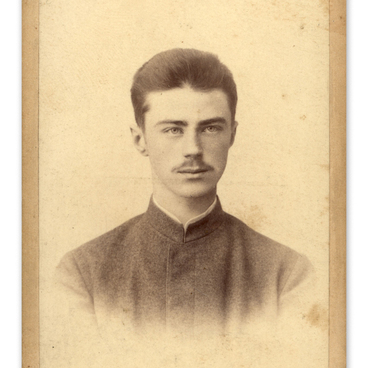The eldest child in the Stoletov family, Vasily, was born in 1825. He learned the basics of reading and writing at home under the supervision of his mother, Alexandra Vasilyevna. Vasily enrolled in the Vladimir Provincial Men’s Gymnasium, but he did not complete his studies there. His father Grigory Mikhailovich Stoletov withdrew his son from middle school because he needed a helper. Vasily assisted his father in the tannery workshop and their shop, and after his father’s death, he managed the businesses on his own.
Thanks to Vasily’s financial support, his younger siblings were able to pursue higher education. Unable to continue his own studies, Vasily Stoletov devoted his entire life to self-education, having a passion not only for fiction but also for scientific literature. His home library included books in foreign languages. He owned Charles Darwin’s book “The Descent of Man, and Selection in Relation to Sex”, which is now kept in the museum. Vasily Stoletov’s social circle extended beyond the merchant class of Vladimir and included members of the local intellectual elite. He arranged his personal life relatively late in life, marrying Maria Gladina in St. Petersburg in January 1863. Maria was the daughter of a prominent St. Petersburg contractor, Grigory Gladin.
Vasily Stoletov’s work involved the execution of contracts, which required him to frequently travel to cities such as St. Petersburg, Moscow, Yaroslavl, and Rybinsk, among others. He proved himself not only as a successful entrepreneur and businessperson, but also as a prominent public figure and philanthropist. In 1870, he was elected to the city duma, where he served for several years. During that time, he contributed money to support the maintenance of the St. Elijah Church, whose congregation included several generations of Stoletovs. Additionally, he joined the local board of the Russian Red Cross society.
In 1891, Vasily Stoletov at his own expense improved the Rozhdestvensky rampart, located across from the Stoletovs’ mansion. The rampart was not only a great place for walks for citizens, but also a venue for religious processions. Thanks to Vasily Stoletov’s efforts, a pathway was laid, a recreation area was built, a lattice fence was installed, benches were placed, and the slopes were covered with grass.
In the last years of his life, Vasily Stoletov
retired. He passed away on February 29, 1896, and was buried at the Prince
Vladimir Cemetery. His wife Maria Stoletova survived him by 22 years and passed
away in 1918, and was buried next to him.


